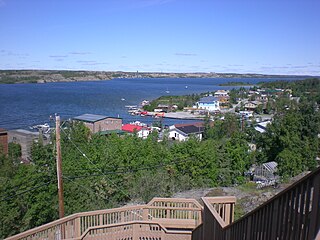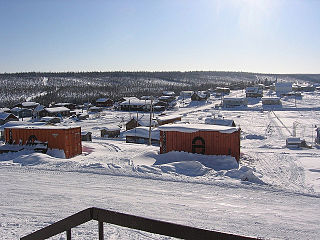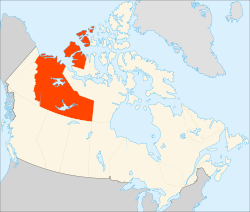
The Northwest Territories is a federal territory of Canada. At a land area of approximately 1,144,000 km2 (442,000 sq mi) and a 2016 census population of 41,790, it is the second-largest and the most populous of the three territories in Northern Canada. Its estimated population as of 2023 is 45,668. Yellowknife is the capital, most populous community, and only city in the territory; its population was 19,569 as of the 2016 census. It became the territorial capital in 1967, following recommendations by the Carrothers Commission.

Yellowknife is the capital, largest community, and only city in the Northwest Territories, Canada. It is on the northern shore of Great Slave Lake, about 400 km (250 mi) south of the Arctic Circle, on the west side of Yellowknife Bay near the outlet of the Yellowknife River.

Inuinnaqtun, is an Inuit language. It is spoken in the central Canadian Arctic. It is related very closely to Inuktitut, and some scholars, such as Richard Condon, believe that Inuinnaqtun is more appropriately classified as a dialect of Inuktitut. The government of Nunavut recognises Inuinnaqtun as an official language in addition to Inuktitut, and together sometimes referred to as Inuktut. It is spoken in the Northwest Territories as well and is recognised as an official language of the territory in addition to Inuvialuktun and Inuktitut.

Kitikmeot Region is an administrative region of Nunavut, Canada. It consists of the southern and eastern parts of Victoria Island with the adjacent part of the mainland as far as the Boothia Peninsula, together with King William Island and the southern portion of Prince of Wales Island. The regional centre is Cambridge Bay.

Cambridge Bay is a hamlet located on Victoria Island in the Kitikmeot Region of Nunavut, Canada. It is the largest settlement on Victoria Island. Cambridge Bay is named for Prince Adolphus, Duke of Cambridge, while the traditional Inuinnaqtun name for the area is Ikaluktutiak or Iqaluktuuttiaq meaning "good fishing place".

Fort Smith is a town in the South Slave Region of the Northwest Territories (NWT), Canada. It is located in the southeastern portion of the Northwest Territories, on the Slave River and adjacent to the Alberta border along the 60th parallel north.

Resolute Bay is an Arctic waterway in the Qikiqtaaluk Region, Nunavut, Canada. It is located in Parry Channelmap on the southern side of Cornwallis Island.map The hamlet of Resolutemap is located on the northern shore of the bay with Resolute Bay Airportmap to the northwest. The Inuit associated with Resolute Bay are called Qausuittuq and the population of the hamlet in the 2006 census was 229.

Nunavut Arctic College is a public community college in the territory of Nunavut, Canada. The college has several campuses throughout the territory and operates as a public agency funded by the territorial government.
Aurora College, formerly Arctic College, is a college located in the Northwest Territories, Canada with campuses in Inuvik, Fort Smith and Yellowknife. They have learning centres in 23 communities in the NWT. The head office for Aurora College is located in Fort Smith.

Fort Good Hope, is a charter community in the Sahtu Region of the Northwest Territories, Canada. It is located on a peninsula between Jackfish Creek and the east bank of the Mackenzie River, about 145 km (90 mi) northwest of Norman Wells.

Bathurst Inlet, is a small Inuit community located in Bathurst Inlet in the Kitikmeot Region of Nunavut, Canada.
Arctic Co-operatives Limited is a cooperative federation owned and controlled by 32 community-based cooperative business enterprises located in Nunavut, Northwest Territories, Yukon and northern Manitoba, Canada. Arctic Co-ops coordinates resources, consolidates the purchasing power and provides operational and technical support to the community-based co-operatives to enable them to provide a wide range of services to their local member-owners. Arctic Co-ops operates in both English and Inuktitut and provides patronage dividends to the local members.

SSi Canada is a Canadian wireless broadband internet service provider primarily serving remote areas that lack terrestrial service options. SSi was established in 1990 by Jeffrey Philipp and is headquartered in Yellowknife, capital of the Northwest Territories. SSi is also a provider of Satellite Communication services, offered in locations that do not have terrestrial service options. They offer turnkey Internet systems to other ISPs. They have a local market serving all 25 communities in Nunavut and several in the Northwest Territories. These two territories account for 1/3 of Canada's landmass covering 3,439,296 km2 (1,327,920 sq mi). They also have an international market including Africa, Indonesia and Kiribati.

Higher education in Canada includes provincial, territorial, indigenous and military higher education systems. The ideal objective of Canadian higher education is to offer every Canadian the opportunity to acquire the skills and knowledge necessary to realize their utmost potential. It aspires to cultivate a world-class workforce, enhance the employment rate of Canadians, and safeguard Canada's enduring prosperity. Higher education programs are intricately designed with the perspective of the learner in focus, striving to mitigate risks and assure definite outcomes.

Higher education in Manitoba includes institutions and systems of higher or advanced education in the province of Manitoba.

Aurora Research Institute, formerly Science Institute of the NWT, is a research centre in the Northwest Territories, Canada. It is part of Aurora College, with offices in Inuvik, Yellowknife and Fort Smith.

Higher education in Nunavut allows residents of this Canadian Arctic territory access to specialized training provided at post-secondary institutions. There are some unique challenges faced by students wishing to pursue advanced training in Nunavut, a vast territory stretching across Arctic Canada from Hudsons Bay to the north pole. The territory was split from the Northwest Territories in 1999, following a successful plebiscite which affirmed Inuit desires to establish an independent political jurisdiction. Covering one-fifth of Canada's area and over 60% of its coastlines, the territory had a population of 31,153 in 2010.
This timeline of Yellowknife history summarises key events in the history of Yellowknife, a city in the Northwest Territories, Canada.
The Nunavut Teacher Education Program (NTEP), formerly the Eastern Arctic Teacher Education Program (EATEP), is an important college / university teacher education program in the territory of Nunavut and is offered through Nunavut Arctic College (NAC). This program provides Inuit from Nunavut with the opportunity to work toward a Bachelor of Education degree while remaining in the territory.

The following outline is provided as an overview of and topical guide to the Northwest Territories:
















